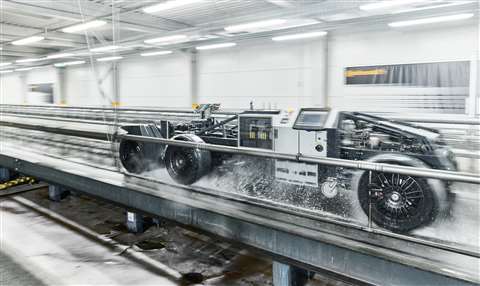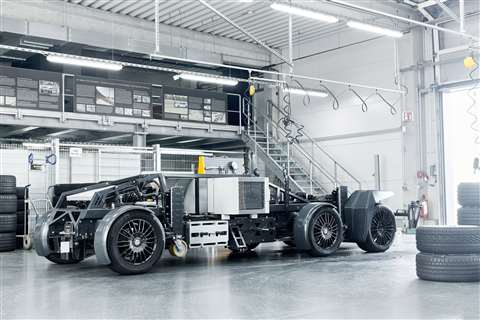Continental reveals electric, driverless tire test rig
04 May 2022
AVA enables monitoring friction characteristics of tires during braking maneuvers
 Continental’s new test rig was designed to measure the braking performance of passenger car tires. (Photo: Continental AG)
Continental’s new test rig was designed to measure the braking performance of passenger car tires. (Photo: Continental AG)
Continental AG has shown a driverless and fully electric test vehicle that it developed for measuring the braking performance of passenger car tires with the objective to reduce the braking distance of tires to ensure greater road safety. The company said AVA – Analytic Vehicle AIVA (Automated Indoor Braking Analyzer) – enables precise monitoring of the frictional properties of tires during braking maneuvers on dry and wet roads.
The Continental AVA combines the advantages of a test method that is independent of the vehicle model, with the controlled and reproducible test environment of the AIBA. Continental can therefore perform tests regardless of vehicle specific characteristics. The test vehicle is used on the company’s proving ground known as Contidrom near Hanover, Germany.
“Our analytic vehicle AVA helps us to analyze the performance of our premium tires in even greater detail and systematically develop them,” said Dr. Boris Mergell, Head of Research and Development of Continental’s Tires group sector. “Transmission of forces between the tire and the road surface is decisive for tire braking performance. It is equally important for cornering characteristics or when changing direction. “The performance of the tire during braking is essential for the safety of the vehicle. For this reason, we make great efforts to analyze our tires as precisely as possible.”
 Continental said AVA combines the advantages of a test method that is independent of the vehicle model with a controlled and reproducible test environment. (Photo: Continental AG)
Continental said AVA combines the advantages of a test method that is independent of the vehicle model with a controlled and reproducible test environment. (Photo: Continental AG)
For the tire braking tests, the AVA is accelerated to 65 km/h with the aid of an electromagnetic linear drive, which is derived from modern roller coaster technology. Then, several fully automated braking tests are carried out. The AVA drive system is equipped with two electrically driven axles, which are powered by a high-performance battery. The high maximum torque ensures that a constant speed can be maintained, while the test tires on the third axle can be systematically braked. The integrated braking system of the AVA is equipped with brake-by-wire technology from Continental’s Automotive business sector. Unlike conventional hydraulic braking systems, the braking signal is transferred electronically. The company said the brake response is very quick and precise, which is essential for accurate testing or measuring.
“Our AVA determines the transmission of forces between the tire and the road surface, while various slipping states are precisely reproducible. With the state-of-the-art measuring technology we measure all of the forces which act between the tire and the road surface during braking. We can compare our tires and their various compound compositions even more precisely and optimize them for their special uses,” said Meletis Xigakis, who is responsible for global tire testing at Continental.
AVA is used in the company’s Automated Indoor Braking Analyzer, which started operation in 2012. Brake tests on various road surfaces are performed on the 75 m test track. The air-conditioned area of the test hall has up to five road surfaces which can be exchanged hydraulically. In the weather-independent facility, up to 100,000 braking tests can be performed annually on dry, wet or even icy roads. The system is integrated into a 350 m long and up to 30 m wide hall.
In total, new Continental tire models are run for the equivalent of 25 million kilometers per year on test beds and test tracks. This corresponds to 625 times around the world.
Together with the company test tracks in Uvalde, Texas, and in Arvidsjaur, Sweden, the Contidrom in Jeversen, near Hanover, Germany, which the company has said is one of the most modern proving grounds in the world. It opened in 1967 and since then has been continuously modernized to meet the increasing requirements on tire tests.
On a total area of 160 hectares, the proving ground includes a 10 km track with a large variety of partly water-covered road surfaces, and on the circuit with banked turns, speeds of more than 250 km/h are achieved. In addition, There are also tracks for testing chassis elements. During 2022, a dynamic driving simulator which can calculate the exact dynamic parameters of the tires and the test vehicle involved will be commissioned at the Contidrom. This provides the professional Continental test drivers with exactly the same subjective driving feel as tire tests on the test track.
STAY CONNECTED




Receive the information you need when you need it through our world-leading magazines, newsletters and daily briefings.
POWER SOURCING GUIDE
The trusted reference and buyer’s guide for 83 years
The original “desktop search engine,” guiding nearly 10,000 users in more than 90 countries it is the primary reference for specifications and details on all the components that go into engine systems.
Visit Now
CONNECT WITH THE TEAM










